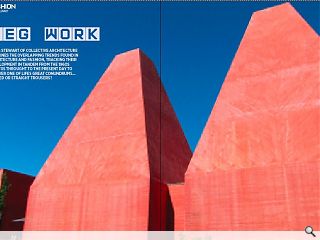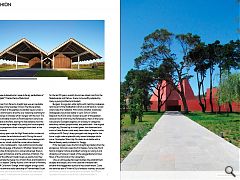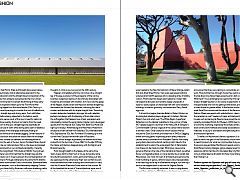Fashion & Architecture
15 Apr 2014
Chris Stewart of Collective Architecture examines the overlapping trends found in architecture and fashion, tracking their development in tandem from the 1960s and 70s through to the present day to answer one of life's great imponderables... Flared or straight trousers?
“There is hope in honest error; none in the icy perfections of the mere stylist” Charles Rennie MackintoshThe conversion from flares to straight legs was an inevitable rite of passage of any teenager living in the late seventies. A young architect of the eighties would later be put under a similar trial and forced to drop the ever widening overhang for the slim pickings of a facade which merges with the roof. This classical revival better known as Postmodernism came to as abrupt an end as the flare, leaving me fascinated by how the width of a trouser leg or length of a jutting roof could expand to enormous proportions then overnight shrink back to the absolute minimum.
Today skinny jeans rule the High Street while a modernist revival dominates the architectural world. During the worst recession in living memory it is monolithic form making which concentrates our minds; while the conservative classical breakdown into multiple parts - tops, bottoms and shoulder pads - are the language of the boom. Whether market trend garnishes a free thinking bull or a conservative bear there is a link between architecture and the extremes of fashion. The time span of the different media mixes up exactly how they align, for example the heady mix of Glam Rock and Brutalism is never easy to explain. Stanley Kubrick’s film version of Anthony Burgess’s ‘A Clockwork Orange’ where dapper droogs cavort amongst the severe brutalist backdrop of Thamesmead South Housing Estate, part explains how these unlikely ingredients manage to blend. The Brutalist environment, out of fashion for the last 30 years, recently found new street cred from the Skateboarder and Parkour Scene, to be swiftly adopted by many a young architectural student.
Burgess’ droogs don white tights with matching codpieces, reminiscent of the Elizabethans which is as far back as I would care to take this metaphor. Who knows whether stylistically Shakespeare would look better in Levis 501s or Oxford Bags but the 1600s were a Golden era, part of the greatest classical revival of all time, the Renaissance. Next on the scene was graceful Georgian elegance, an era easy to categorise; beautifully refined, proportioned, and pared back - the original straight-leg. Dressed up in muted green, the distressed blue world of Jane Austen could easily have ridden a Vespa scooter, while proud Mr Darcy’s sharp pronged coat designed for the horse, might make a splendid misty lensed drainpipe stride into a Christopher Wren folly. No doubt to do battle with a Bennet beauty easily mistaken for Twiggy.
If the Georgians were the first straight-leg hipsters then the prosperous Victorians were the first hippies. Some may find it hard to imagine Victoria and Albert turning on, tuning in and dropping out however I speak of the exaggerated enormous flares of the Osmonds or the Carpenters.
Once a cutting edge has been blunted, the establishment accepts and adopts, and in this case the oversized flare became the exaggerated symbol of hip conservatism. Could the same be said of Violet le Duc’s fantastic visionary structural protrusions, picked out by the prim and proper John Ruskin to preach revolution to the Arts & Crafts movement? It was here that Morris, Web and Rossetti discovered nature, beauty, asymmetry and an alternative approach to the staunch classicism and the straight laced composition of the Raphaelite. Now properly recognised as the fore runners of the environmental movement the thinking of these early naturalists inspired a nation up to the First World War.
Having slipped into the more familiar 20th Century, it would be worth pausing to consider the root of bellbottoms, boot cut, straight legs and skinny jeans. Form did follow function before being subjected to the fashion world; bellbottoms were a result of the navy’s need for sailors to remove shoes quickly; the boot cut stems from the need to give room to the spur; straight legs are essentially an economical use of cloth; while skinny jeans seem a rebellious over emphasis of the drainpipe eventually finding an established home as the dreaded jegging. Similar reasons of form and function should be the raison d’être for the shape of the eaves; climate can demand an overhang either as shelter from the wet or the sun, here in Scotland flares should probably be our national dress. Not so, the skew and parapet feature prominently in our architectural identity, I recently quizzed the magnificent TOG studio at SEDA’s Young Green Drinks where I was informed that the straight-leg was the favoured deck out in Tiree to prevent the roof being blown off. A recent trip to Portugal, battered by the same North Atlantic swell, showed some similar Celtic connections. Elsewhere flares have been adopted, such as the elaborately stepping Chinese Dougong or those thrifty American craftsmen sheltering cattle underneath out-stretched extended roofs. Please bear these thoughts in mind as we now pull on the 20th century.
Flappers immediately shimmy into mind, a true straight-leg of the age, a product of the prosperity of the roaring twenties, fueled by a feeling of discontinuity associated with modernity and a break with tradition. Art Deco was the getup of the flapper; stylish, brash and they kick started straight-leg domination for the next few decades, mirroring the rise of modern architecture with its simple straight lines. These truly modern ladies also heralded a stronger link with rebellion, perhaps not always with the blessing of their older sisters the suffragettes; the Flappers love of jazz, expression and individuality inspired the early hipster. Hipster roots developed quickly from the Hepcat 30s, Teddy 40s, Beat 50s, Mods 60s right up to today’s Williamsburg and Meta Nerd. Modernism strutted a similar catwalk from Bauhaus 30s, Internationalist 40s, Expressionist 50s, Neo Formalist 60s leading up to the current Neo Classical revival with dash of Fascismo.
After all this straight leg mastery the fashion world was rocked from the Summer of Love (1967) to the late 1970s by the hippie; architecture stepped along with Archigram and Brutalist severity.
Punk brought death to the hippie, at the same time Team 4 gave birth to High Tech or to use its Sunday name Structural Expressionism. Joints, parts and ‘hangy out’ bits are expressed to the extreme by High Tech so that one can misunderstand how their buildings are constructed or used, a bit like Vivienne Westwood’s bra worn on the outside. All of this heralded the arrival of ‘the architectural super era of the flare’ in the form of Post Modernist excess. Elsewhere we were treated to the New Romanticism of Steve Strange, Adam Ant and Janet Street Porter. Tops were expressed, bottoms widened and midriffs exposed, all in a dazzling array of blobby colours. Postmodernist design was treated to a major V&A retrospective last year, but remains deeply unpopular. A style too easily copied, we have been left with some dreadful buildings, numerous gimmicky corkscrews and Terry Farrell egg cups.
It is hard to imagine Spandau Ballet or Robert Venturi as shocking but rebellion plays a large part in fashion. Norman Mailer’s foul rant which was ‘The White Negro: Superficial Reflections on the Hipster’ published in the summer of hate 1957 (please support a summer of No Hate 2014 at Glasgow’s Commonwealth Games) is typical of the conservative reaction to all that is new. Other costumes which caused offence include the Zoot Suit which provoked riots in 1943 or Sagging where low hung pants inspired by prison safety measures caused serious comment from President Obama. How many young feisty deconstructionist paintings did it take for the establishment to adorn the extravagant flair of Zaha Hadid, now these can be made to order. What does cause some genuine offence is the robe of the standard architect, we either favour unimaginative black, or crave identity like a scarlet clad Mike Davies. Our most introvert of architects proved to be the most humbling of genius, Antonio Gaudi was unrecognisable in his hobo rags as he lay in a Barcelona morgue, run over by a tram as he stepped back to admire the Sagrida Familia.
The Arts are constantly entwined, it was a crying shame to read ‘Fats all Folks’ as FAT (Fashion, Architecture and Taste) announced that they were retiring to concentrate on solo work. More hid than hip, through choice they swam against the tide like a long haired hippy pogoing at a Clash concert. What next? The overhanging box seems the first sign that today’s straight-leg has run its course as exponents of the merged facade and roof are getting a little bored, preferring to stack these for greater effect. In the fashion world last week Kate Moss announced the return of the flare and Milan Fashion Week was awash with wide bottoms - dare I also say the recession is over? Leaders of major architectural fashion houses such as Herzog de Meuron have joined the call, their recently completed Parish Art Museum (2013) has more than a nod to the overhang; inspired by the simple vernacular, local construction methods and readily accessible building materials. It is a joy to see reason and light being the source of architectural inspiration.
To reflect on Mackintosh’s famous quotation, it is an easy path to mimic the garb of the Fashionista, much more difficult to search properly for what our communities truly want. For those who enjoyed Gillies MacKinnon’s award winning film Small Faces tracking Glasgow gangs, please never forget the expansive tartan hemline of a futureless Bay City Roller fan living in a Basil Spence Brutalist shit hole; more Shang a Lang than Shangri-La.
Petition against the Ugandan anti gay bill.
|
|
Read next: Cecil Balmond
Read previous: Hull
Back to April 2014
Browse Features Archive
Search
News
For more news from the industry visit our News section.
Features & Reports
For more information from the industry visit our Features & Reports section.





